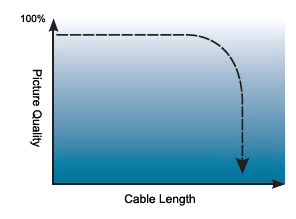Sign in

Please check your email address and password.
Navigation |
Cable-Based A/V DistributionCable-Based A/V DistributionIn-line basedIn-line extenders, installed at some point within a link, extend signals over their native cabling with no signal conversion occurring. These amplification or repeater types of devices are designed to equalize and amplify the signal to go greater distances. Some support daisychaining, so by stringing two of them together you can send data double the distance. But in-line extenders can only take the signal so far and typically use amplification that not only boosts the video signal, but also boosts any noise on the cable. In addition, they don’t solve the problem of having to transmit bidirectional serial control signals to the display.  Non-networked CATx-basedThis method uses transmitters and receivers to extend converted signals over non-networked UTP cabling. They’re very cost-effective, enabling much longer distances than what’s ordinarily possible with analog or digital video cabling. Copper-based extension is also a great alternative to using standard video or RGB coax cables, which often can’t be easily pulled through tight conduits and can be more difficult to terminate (for more on the limitations of simply extending video cabling, see below). A bonus: In most buildings, copper cabling is already installed to service data communications. There’s no need to pull new cabling when existing wiring can be used for long-distance AV distribution instead. Another thing to consider: Coax- or VGA-cabled extension installations usually require a separate RS-232 or other line for transmitting the control signal for a display—yet another cable to fit into the conduit and another distance limitation (most serial signals can travel only a short distance over traditional cable). Some CATx-based extenders also extend serial control signals in addition to video and audio. Therefore the cable can deliver both the video and control signals through a single transmission medium. Plus, CATx extension technology continues to evolve. Newer HDBaseT™ technology uses sophisticated encoding and equalization techniques to deliver uncompressed DVI or HDMI video and audio, 100BASE-T Ethernet, power, and control signals to a remote screen—all over a single CATx cable. HDBaseT has made it possible to transmit the video signal as well as the peripheral signals uncompressed up to 100 meters.  Non-networked fiber-basedUsing fiber-based technology has many advantages over copper-based distribution technology. Foremost, it enables you to deliver video at much longer distances than copper—without compromising the quality of the original video signal. This makes it an ideal distribution method for digital signage. Plus, it supports high resolutions and the sending of large, bandwidthconsuming files, particularly in electronically noisy environments, such as in transit stations. Because fiber is made of glass, which is an insulator, no electric current can flow through. This makes it immune to EMI/RFI interference. You can run fiber next to industrial equipment without worry. And, compared with copper cable, fiber cable is less susceptible to temperature fluctuations. In addition, fiber distribution is ideal for applications where data security is a priority, such as in medical, military, and government environments. That’s because fiber cable is extremely difficult to tap. And fiber cable is more durable than copper cable, and it’s thinner. Its size makes it easier to handle, and it takes up less space in cabling ducts. Yes, fiber is more expensive, but many fiber-based extenders use just a single strand of fiber, for a more economical use of your fiber count.  Why not just run longer cables?An analog video signal can be run over long lengths of native VGA cable as long as its diameter and shielding is good enough. However, regardless of the cable quality, signal attenuation increases with video frequency and cable length. This means that after 30 to 50 feet, the image quality will start to degrade. This leads to color skew and smeared-looking text. To solve for signal degradation in VGA video applications, use an equalizer, or an extender that compensates for signal loss. A good extender has separate adjustments for high and low frequencies; HF loss is usually greater than LF loss. Analog signals travel in a sine-like wave form; digital DVI and HDMI signals travel in a square-like waveform. The signal is broken into a binary format where the audio or video data is represented by a series of 1s and 0s. Like analog signals, digital video also suffers from cable loss, but as long as the cable is of sufficient quality and within the maximum supported distance, the signals don’t suffer blurring or color skew. So what happens when the maximum supported length is exceeded? You get the “cliff” effect, where the signal drops off and you completely lose the picture. To overcome distance limitations, use extenders or repeaters. Picture quality of an analog signal gradually declines over longer lengths of cable.  Picture quality of an digital signal (e.g. HDMI) suddenly drops at a certain length of cable (cliff effect).  |